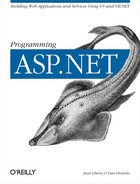ASP.NET offers three related list-bound controls: Repeater, DataList, and DataGrid. These controls support the display of repeating data such as database reports, shopping carts, menus, and query results. These are among the most powerful controls in ASP.NET and mastering them is key to creating viable commercial applications.
The Repeater is a lightweight control that derives directly from the
base Control class. It is
lookless, which means that there is no
predefined user interface or style; the developer is free to provide
virtually any look to the Repeater through the use of
templates.
Repeaters are ideal when the developer must maintain
complete control over the look and feel of the control.
Note
Templates are HTML elements that define the content and rendering of a Repeater or other control. You create a template as you would any HTML element, for example:
<template name="myTemplate">
Programming C#
</template>Within the template you may nest other HTML elements such as labels
and text. Templates are discussed in detail in
Chapter 13.
The DataList control derives from the BaseDataList class, as does the DataGrid. The BaseDataList class derives in turn from the WebControl class, which derives from the Control class (see Figure 4-5 in Chapter 4, which depicts the relationship of controls in the System.Web.UI.WebControls namespace). The DataList displays either a columnar or a normal HTML flow layout. It also provides support for selection, editing, and deleting of items.
Tip
Flow layout describes how the text on an HTML page will be displayed. In normal HTML the text is written across the page, in columnar layout the text is arranged in columns.
The DataGrid displays its data in a table of columns and rows. Like the DataList, the DataGrid provides style and appearance properties as well as selection and editing. The DataGrid also supports sorting of columns and paging through the data. Unlike the DataList, the DataGrid does not support template properties; the rows of the control cannot be controlled by templates. It is possible to add a TemplateColumn object to the DataGrid, however, which allows the use of templates within that column. We’ll return to templates later in this chapter.
Table 10-1 illustrates the principal differences among the three list-bound controls.
Table 10-1. Features of the list-bound controls
|
Feature |
Repeater |
DataList |
DataGrid |
|---|---|---|---|
|
Column layout |
No |
Yes |
No |
|
Flow layout |
Yes |
Yes |
No |
|
Paging |
No |
No |
Yes |
|
Select/ Edit/Delete |
No |
Yes |
Yes |
|
Sort |
No |
No |
Yes |
|
Style properties |
No |
Yes |
Yes |
|
Table layout |
No |
No |
Yes |
|
Templates |
Yes |
Yes |
Columns/ optional |
If you examine this table closely, you find that Repeaters have no look to them, and offer only a flow layout. They are entirely controlled by templates. DataLists offer either flow or column layout, and their look is controlled by style properties and templates. DataLists also support selection, editing, and deletion, but not sorting and paging. DataGrids, finally, support table layout only; their look is controlled with style properties and optionally with column templates, and they support not only selection, editing, and deletion, but also sorting and paging.
This chapter will introduce and discuss the DataGrid control using an
ArrayList as the data source. In Chapter 11,
we’ll explain how to access data in the
database.
Chapter 12 will
cover updating data using ADO.NET. Then in Chapter 13, we’ll return to the DataGrid
control to bind to a database and continue the discussion of
list-bound controls by examining the DataList and Repeater controls.
Before delving into the specifics of each list-bound control, this chapter will examine the features all three controls share in common.
All the list-bound controls have a DataSource property. This property
defines the source for data binding, as you’ve seen
earlier with other controls. A DataSource can be any object that
implements the System.Collections.ICollection
interface: an array, a dataset, or some other homogeneous collection
of objects. Often, the data source will be a
System.Data.Dataview object, as
discussed in Chapter 11. For simplicity, in this
chapter you will continue to use an ArrayList object, though you can
use any object that implements System.Collections.ICollection, such
as a HashTable or an Array object.
The three list-bound controls also contain an Items property that returns a collection of objects representing an item (row) in the data source collection. You use the Items collection to manipulate the items in the list control programmatically.
Tip
The Repeater control’s Items property returns a collection of RepeaterItem objects, the DataList control’s Items property returns a collection of DataListItem objects, and the DataGrid control’s Items property returns DataGridItem objects.
The DataGridItem object has an
ItemType property that returns an
enumerated ListItemType. The members of
the ListItemType
enumeration are shown in Table 10-2.
Table 10-2. Members of the ListItemType enumeration
|
List item type |
Purpose |
|---|---|
|
Every other item | |
|
Used for in-place editing; see Chapter 13 | |
|
Display footer for control | |
|
Display header information for control | |
|
Displays information about data item | |
|
Display paging information | |
|
The item the user has selected | |
|
Appears between items |
Manipulation of the various types of members of the Items collection will be demonstrated throughout the rest of this chapter.
All of the list-bound controls follow the explicit binding method. When its DataBind method is called, the list-bound control enumerates its data source, creating DataListItems and initializing them from the DataSource items. The DataListItem objects are then added to the list-bound control’s Items collection. Because this happens only on demand, there are fewer round trips to the server than might otherwise be expected.
